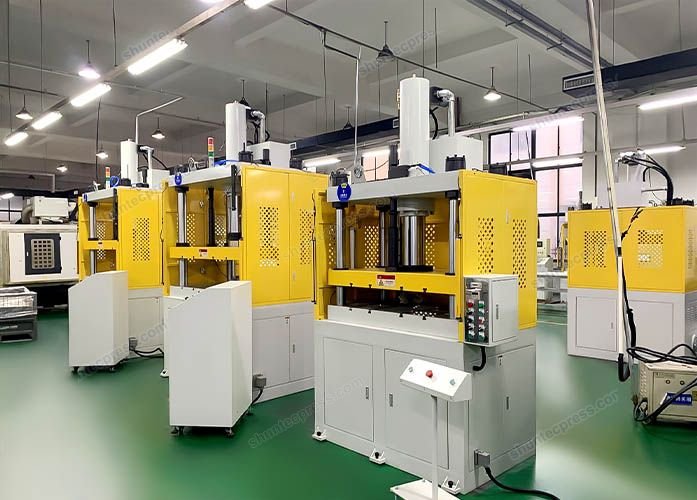
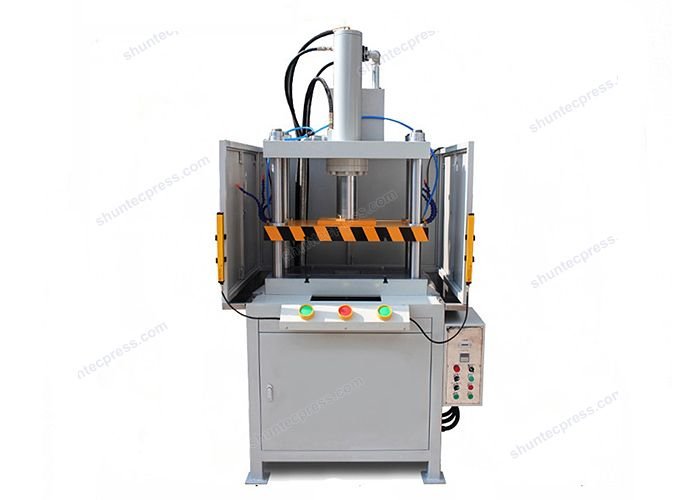
Performance
1. The four-column structure of a small hydraulic press, simple, economical, and practical. The frame structure has good rigidity, high precision, and strong anti-fraud load ability.
2. The hydraulic control system adopts the integral cartridge valves. The leakage point of the hydraulic system is reduced. The small hydraulic press acts smoothly and reliably, yet with long service life.
3. PLC control which is sensitive, reliable, and flexible. The working pressure and stroke can be adjusted within the specified range according to the process requirements. The machine operation is simple.
5. There are three operation modes: manual adjustment, two-hand semi-auto cycling, and automatically continuous working cycle (with an automatic feeding device).
6. Rotary selector switch of the three processing operations optional: cycles with cushion, without cushion, ejecting.
Characteristics
1. The design of this model adopts four-column and three-plate open space, and the four columns are respectively equipped with self-lubricating bearings.
2. The working area is sufficient. It is suitable for the installation of larger molds, and suitable for large-area leveling, punching, bending, etc.
3. The hydraulic circuit design is simple. The motor power demand is small, and the maintenance is easy. The circuit design can also be changed according to the customer's work requirements to achieve the purpose of the work.
4. The machine can be moved freely with wheels.
5. Two-hand operation, safety light curtain, and interlocked safety mesh shield are installed to ensure safe operation.
6. The rotary indexing plate, automatic feeding devices, and returning devices are optional.
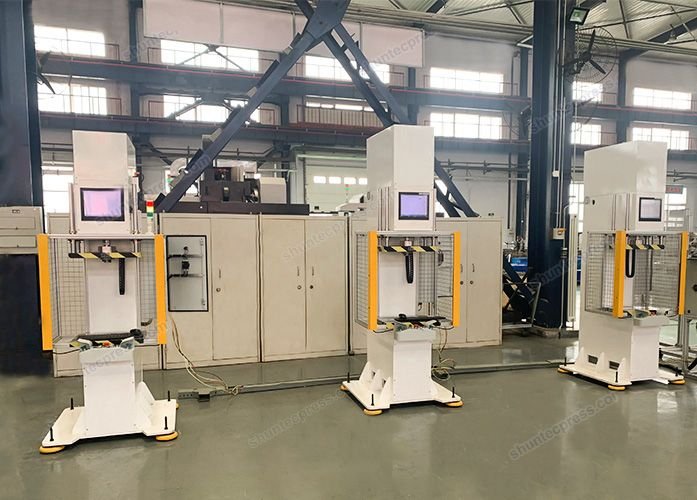
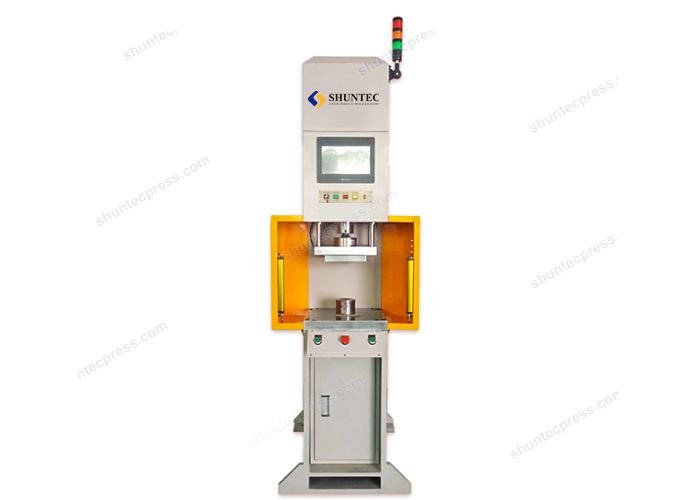
Servomechanism, short for servo, is a technology commonly used in control engineering. It is a kind of control system that uses feedback or error-sensing/correction signals to control mechanical position, speed, attitude, etc. Servomechanism can achieve a higher level of precision/accuracy than another system.
A Servomechanism Is Strictly Defined
To better understand servo, we can compare automotive power window control and cruise control. When the driver operates the window (up or down), he has to observe the position of the window glass and adjust it until it reaches the desired position. During the process, there is no automatic feedback to control the position of the glass. Therefore, an automotive power window control does not belong to servomechanism. By comparison, a car’s cruise control is a typical example of servomechanism, since it uses closed-loop feedback to control the speed.
Nowadays, Servo Technology Has Been Applied To Press Machines
A servo press is a kind of press machine which is driven by an AC servo motor. Instead of a hydraulic or mechanical flywheel system, a servo press uses an electric actuator to control the ram throughout the stroke, and the level of precision can be high.
After the torque is produced, a ball screw will convert it into a linear force. Generally, a servo press is equipped with a load cell and encoder to control pressure and position.
Servo presses can be regarded as an evolved type of press machine since they used more advanced technology. So what’s the difference between servo press and ordinary press? A servo press is driven by a servo motor that features high torque and low rpm, as opposed to a standard electric motor, flywheel, clutch, and brake. A servo press can supply full energy even at low speeds.
Due to its various advantages, such as lower power consumption, servo presses have been extensively used in a variety of applications, such as embossing, forming, shallow drawing, shaping, press-fitting, etc. Particularly, a servo press can achieve variable slide velocity at multiple points throughout the stroke, so it is especially ideal for metal forming, shallow-to-medium drawing, and forming.
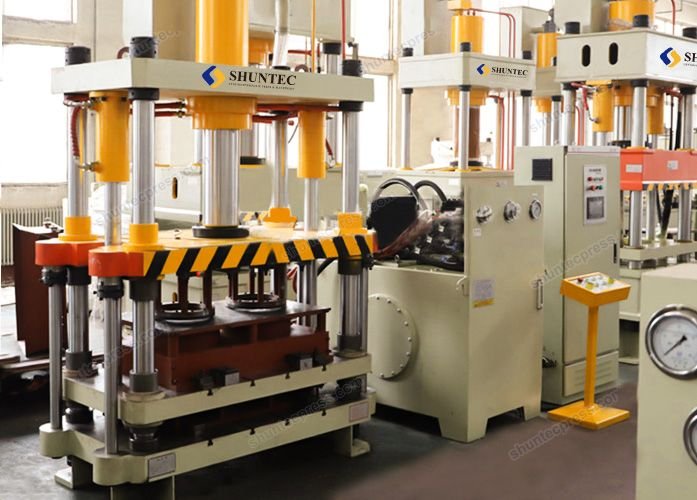
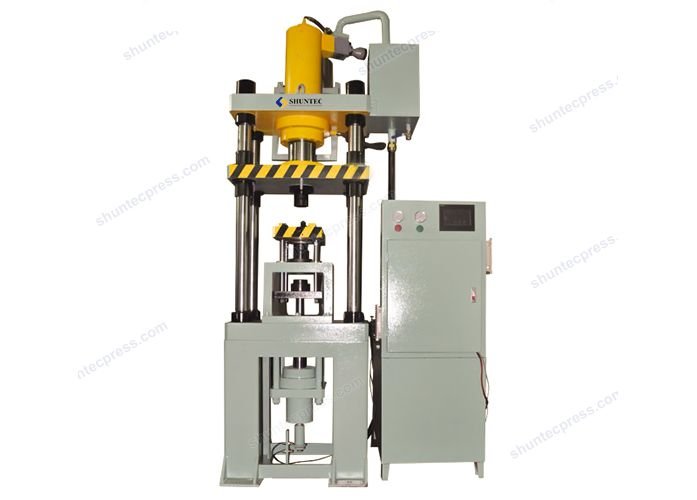
Powder compacting/forming hydraulic press is a kind of press machine that compresses powder of different materials into intended shape, size, and density. It is a process when the power is becoming solid of the required shape. Applicable powder material includes pure metal or alloy, non-metal, metal and non-metal compound, etc.
Typical structures of powder compacting/forming hydraulic presses include three-beam & four-column, two-beam & four-column, four-beam & four-column, etc. A powder compacting/forming hydraulic press with more columns not only has a larger volume but can achieve a higher level of rigidity and precision as well. The press is equipped with independent hydraulic and electrical systems and automatic feeding devices, which greatly facilitate the forming process.
Features Of Powder Compacting/Forming Hydraulic Press
1. The mold base can be used for internally concave and externally convex products. It has a stepping adjustment mechanism for molded products, a floating mandrel mechanism, and a powder filling mechanism. Thin products with step differences can be easily molded.
2. The press is equipped with an upper punch pressure holding mechanism. With this mechanism, the molded products and the upper punch are still under pressure when they reach the end of the extrusion so as to prevent the molded products from deforming and cracking during extrusion.
3. The press can realize functions such as middle mold balance, floating plate balance, filling pause, and extrusion pause.
4. The method of electric forced lubrication is adopted to lubricate the machine.
5. Human-machine interface dialogue operation mode s available, which is simple and convenient, and cost-saving for maintenance.
Application Of Powder Compacting/Forming Hydraulic Presses
Powder compacting/forming hydraulic presses are widely used in industries that require powder compression moldings, such as inductive magnetic cores, powder metallurgy, precision ceramics, hard alloys, and magnetic materials. They are especially suitable for compression molding of multi-step and complex products, such as magnetic materials, inductance integrated molding, precision ceramics, 5G filters, powder metallurgy, fasteners, stamping, and molding, new energy, lithium batteries, auto parts, 3C, and other industries.
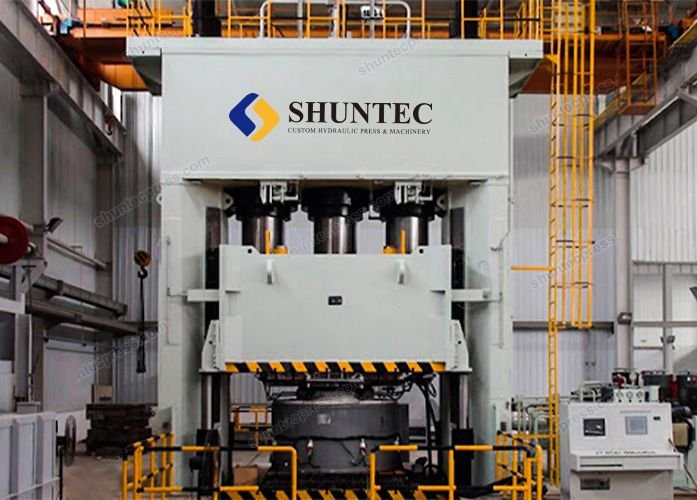
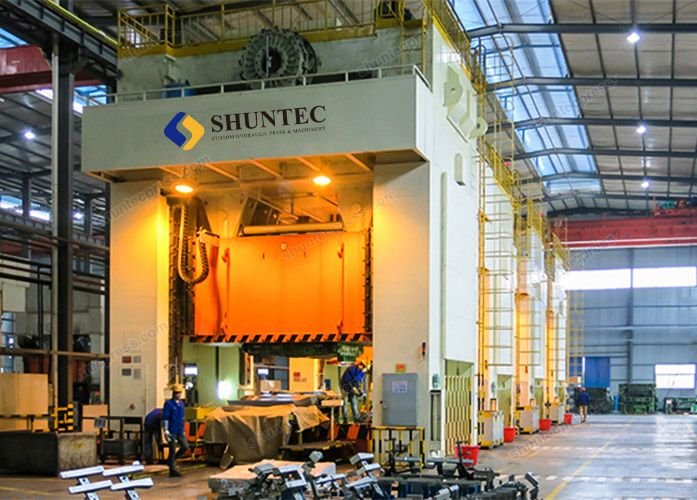
According to actual functions and applications, the hydraulic presses can be divided into different types, such as forging hydraulic press, stretching hydraulic press, correction hydraulic press, and so on. Today’s topic is forging hydraulic press.
What Are Forging And Forging Hydraulic Press
Forging is a manufacturing process that uses compressive forces to shape metal into the intended geometry. Before industrialization, such forces came from hand hammers and manpower, which were not large enough to process larger and stronger parts. Therefore, people began to consider using machines to take the place of hammers and manpower, and forging press was born in response to the needs of a larger and stronger power.
Forging presses are specifically used for the process of press forging. It can be divided into mechanical forging press and hydraulic forging press. Nowadays, hydraulic forging presses are much preferred to mechanical types due to their unique advantages.
Features And Advantages Of Forging Hydraulic Press
1. The pressurizing energy can be pre-set simply and accurately. The system is driven directly by the servo motor, and the running speed is fast.
2. There is no structural bottom dead center and the situation of sliding jam so that the pressing and forging result is more uniform.
3. When approaching the bottom dead center, the slider speed is extremely fast. It only takes a very short time for the die to extrude the material. By virtue of the above, the service life of the die can be greatly prolonged.
3. The whole structure is very simple with the direct drive of the servo motor, and the maintenance cost is low.
4. The slider has two control modes: constant stroke and constant pressure, which can realize the functions of pressure holding and delay. The working pressure and stroke size can be adjusted within the specified range according to the process requirements.
5. The electrical control system has two control schemes: relay and PLC. The electrical system controlled by PLC is sensitive, reliable, and flexible. The operation buttons are distributed on the panel and there is an active button station, which is convenient to operate.
One Key Technology In Forging Hydraulic Press
Among various technologies that are applied by a forging hydraulic press, there is a very noticeable technology that can greatly save power and improve efficiency. For a traditional hydraulic oil system, when the pressing speed is improving, the press will require more motor power
and pump flow. Sometimes when the pressing speed is low, the press will run at a motor power that is higher than necessary, and so there is a waste of power. With the above-mentioned technology, the press can calculate the required oil flow for each running step. When the press generates additional energy during slow pressing, the system can storage it via electromagnetic valves to the accumulator. Then during fast pressing, the system will give a signal to start the accumulator which will release the additional energy to supplement the fast pressing process. In real applications, more than one accumulator is added to the forging press to store and release additional energy, so as to save power and improve efficiency.

